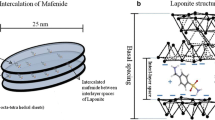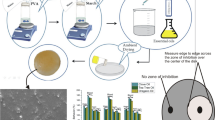Abstract
In this study, attapulgite clay was extracted from North Western desert of Borg El-Arab, Egypt. The pristine clay was purified and treated before further use. The mineralogical composition of pristine clay was investigated by TEM, SEM, XRD and EDX analyses. Moreover, the pristine clay was organically modified with hexadecyl trimethyl ammonium chloride before incorporating into PVA-HES membranes. The modification of clay was also verified by FTIR, SEM and XRD analyses. Meanwhile, PVA-hydroxyethyl starch (PVA-HES/modified attapulgite clay) composite hydrogel membranes were fabricated by solution-casting method, where citric acid was utilized as cross-linker for formation of cross-linked membranes. The influence of addition of Egyptian modified attapulgite clay in ratios (0, 1.0, 3.0, 5.0, 7.0 and 10 wt%) on properties of PVA-HES composite membranes was studied in detail. Results revealed that the incorporation of modified attapulgite clay into membranes increased significantly the swelling ability and mechanical stability of composed hydrogel membranes. Also, the increase in clay contents in membranes showed antimicrobial activity against tested six pathogen strains and adequate hemolytic behavior, compared to clay-free membranes. These findings are referring to the capability of using of PVA-HES–attapulgite composite membrane as a good candidate for the purpose of super-absorbent dermal wound dressings.










Similar content being viewed by others
Abbreviations
- PVA:
-
Polyvinyl alcohol
- HES:
-
Hydroxyethyl starch
- CA:
-
Citric acid
- HDTMA:
-
Hexadecyl trimethyl ammonium chloride
- FTIR:
-
Fourier-transform infrared spectroscopy
- XRD:
-
X-ray diffraction
- SEM:
-
Scanning electron microscopy
- EDX:
-
Energy-dispersive X-ray spectroscopy
- TEM:
-
Transmission electron microscopy
- SWR (%):
-
Swelling ratio percentage
References
Kim, M.H.; Choi, G.; Elzatahry, A.; Vinu, A.; Choy, Y.; Choy, J.H.: Review of clay-drug hybrid materials for biomedical applications: administration routes. Clays Clay Miner. 64, 115–130 (2016)
Jlassi, K.; Chehimi, M.M.; Thomas, S.: Clay–Polymer Nanocomposites, 1st edn. Elsevier, Amsterdam (2017)
Carretero, M.I.: Clay minerals and their beneficial effects upon human health. A review. Appl. Clay Sci. 21, 155–163 (2002)
Bradley, W.: The structural scheme of attapulgite. A Mineral. Earth Planet Mater. 25, 405–410 (1940)
Bergaya, F.; Lagaly, G.: Handbook of Clay Science, vol. 5, 2nd edn. Elsevier, Amsterdam (2013)
Ghrab, S.; Eloussaief, M.; Lambert, S.; Bouaziz, S.; Benzina, M.: Adsorption of terpenic compounds onto organo-palygorskite. Environ. Sci. Pollut. Res. 25, 18251–18262 (2018)
Wang, W.; Wang, A.: Recent progress in dispersion of palygorskite crystal bundles for nanocomposites. Appl. Clay Sci. 119, 18–30 (2016)
Ray, S.S.; Bousmina, M.: Biodegradable polymers and their layered silicate nanocomposites: in greening the 21st century materials world. Prog. Mater. Sci. 50, 962–1079 (2005)
Campbell, F.C.: Fatigue and Fracture: Understanding the Basics. ASM International, Cleveland, OH (2012)
Pal, K.; Banthia, A.K.; Majumdar, D.K.: Preparation and characterization of polyvinyl alcohol-gelatin hydrogel membranes for biomedical applications. AAPS PharmSciTech 8, E142–E146 (2007)
Kamoun, E.A.; Kenawy, E.R.S.; Chen, X.: A review on polymeric hydrogel membranes for wound dressing applications: PVA-based hydrogel dressings. J. Adv. Res. 8, 217–233 (2017)
Nasef, S.M.; Khozemy, E.E.; Kamoun, E.A.; El-Gendi, H.: Gamma radiation-induced crosslinked composite membranes based on polyvinyl alcohol/chitosan/AgNO3/vitamin E for biomedical applications. Int. J. Biol. Macromol. 137, 878–885 (2019)
Rashed, M.A.: Calcrete on Pleistocene coastal ridges, west Alexandria, Egypt: sedimentary nature and applications. Sedimentol. Egypt 6, 113–128 (1998)
El-Shahat, A.: Quaternary D’une carbonates from the Mediterranean coast of Egypt: petrography and diagenesis. Facies 33, 265–275 (1995)
El-asmar, H.M.; Wood, P.: Quaternary shoreline development: the northwestern coast of Egypt. Quat. Sci. Rev. 19, 1137–1149 (2000)
Moore, D.M.; Reynolds, R.C.: X-Ray Diffraction and the Identification and Analysis of Clay Mineral, 2nd edn. Oxford University Press, Oxford (1997)
Poppe, L.J.; Paskevich, V.F.; Hathaway, J.C.; Blackwood, D.S.: A laboratory manual for X-ray powder diffraction. US Geol. Surv. Open-File. Rep. 1(041), 1–88 (2001)
Kamoun, E.A.; Menzel, H.: HES-HEMA nanocomposite polymer hydrogels: Swelling behavior and characterization. J. Polym. Res. 19, 9851 (2012)
Vajanthri, K.Y.: PVA-Bentonite COMPOSITE for wound Dressing. National Institute of Technology Rourkela, Odisha (2014)
Kherroub, D.E.; Belbachir, M.; Lamouri, S.: Preparation and characterization of organophilic montmorillonite (12-maghnite) using Algerian clay. Orient. J. Chem. 30, 1647–1651 (2014)
Huo, C.; Yang, H.: Synthesis and characterization of ZnO/palygorskite. Appl. Clay Sci. 50, 362–366 (2010)
Dos Santos Soares, D.; Fernandes, C.S.; da Costa, A.C.S.; Raffin, F.N.; Acchar, W.; Moura, T.F.: Characterization of palygorskite clay from Piauí, Brazil and its potential use as excipient for solid dosage forms containing anti-tuberculosis drugs. J. Therm. Anal. Calorim. 113, 551–558 (2013)
Boudriche, L.; Calvet, R.; Hamdi, B.; Balard, H.: Effect of acid treatment on surface properties evolution of attapulgite clay: An application of inverse gas chromatography. Colloids Surf. A Physicochem. Eng. Asp. 392, 45–54 (2011)
Murray, H.H.: Applied Clay Mineralogy. Developments in Clay Sciences 2, 1st edn. Elsevier, Amsterdam (2007)
Welton, J.E.: SEM Petrology Atlas. The American Association of Petroleum Geologists, Tulsa (2003)
Lu, L.; Li, X.Y.; Liu, X.Q.; Wang, Z.M.; Sun, L.B.: Enhancing the hydrostability and catalytic performance of metal-organic frameworks by hybridizing with attapulgite, a natural clay. J. Mater. Chem. A3, 6998–7005 (2015)
Seetapan, N.; Anasuwan, N.; Kiatkamjornwong, S.: Superabsorbent polymer nanocomposites with surfactant- or acid-modified Ca-montmorillonite: synthesis and water absorbency. J. Polym. Res. 22, 1–8 (2015)
Tan, L.; Tang, A.; Zou, Y.; Long, M.; Zhang, Y.; Ouyang, J.; Chen, J.: Sb2Se3assembling Sb2O3@ attapulgite as an emerging composites for catalytic hydrogenation of p-nitrophenol. Sci. Rep. 7, 1–11 (2017)
Ltifi, I.; Ayari, F.; Hassen Chehimi, D.; Ayadi, M.: Study of the adsorption of bright green by a natural clay and modified. J. Mater. Sci. Eng. 6, 2169-0022 (2017)
Haraguchi, K.; Takehisa, T.: Nanocomposite hydrogels: a unique organic-inorganic network structure with extraordinary mechanical, optical, and swelling/de-swelling properties. Adv. Mater. 14, 1120–1124 (2002)
Peng, L.; Liu, Y.; Gong, J.; Zhang, K.; Ma, J.: Continuous fabrication of multi-stimuli responsive graphene oxide composite hydrogel fibers by microfluidics. RSC Adv. 7, 19243–19249 (2017)
Kamoun, E.A.; Omer, A.M.; Abu-Serie, M.M.; Khattab, S.N.; Ahmed, H.M.; Elbardan, A.A.: Photopolymer-ized PVA-g-GMA hydrogels for biomedical applications: factors affecting hydrogel formation and bioevaluation tests. Arab. J. Sci. Eng. 43, 3565–3575 (2018)
Mai, Y.-W.; Yu, Z.-Z.: Polymer Nanocomposites. WOODHEAD Publishing Materials, CRC, Cambridge (2006)
Fahmy, A.; Kamoun, E.A.; El-Eisawy, R.; El-Fakharany, E.M.; Taha, T.H.; El-Damhougy, B.K.; Abdelhai, F.: Poly(vinyl alcohol)-hyaluronic acid membranes for wound dressing applications: synthesis and in vitro bio-evaluations. J. Braz. Chem. Soc. 26, 1466–1474 (2015)
Author information
Authors and Affiliations
Corresponding author
Ethics declarations
Conflict of interest
The authors report no conflicts of interest in this work.
Electronic supplementary material
Below is the link to the electronic supplementary material.
Rights and permissions
About this article
Cite this article
Elbassyoni, S., Kamoun, E.A., Taha, T.H. et al. Effect of Egyptian Attapulgite Clay on the Properties of PVA-HES–Clay Nanocomposite Hydrogel Membranes for Wound Dressing Applications. Arab J Sci Eng 45, 4737–4749 (2020). https://doi.org/10.1007/s13369-020-04501-x
Received:
Accepted:
Published:
Issue Date:
DOI: https://doi.org/10.1007/s13369-020-04501-x




